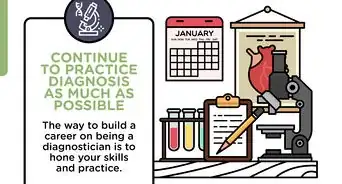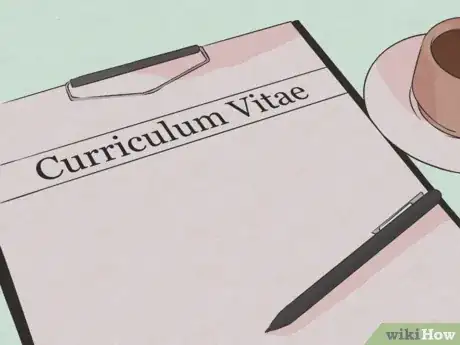This article was co-authored by Chris Hasegawa, PhD and by wikiHow staff writer, Jennifer Mueller, JD. Dr. Chris Hasegawa was a Science Professor and the Dean at California State University Monterey Bay. Dr. Hasegawa specializes in teaching complex scientific concepts to students. He holds a BS in Biochemistry, a Master’s in Education, and his teaching credential from The University of California, Davis. He earned his PhD in Curriculum and Instruction from The University of Oregon. Before becoming a professor, Dr. Hasegawa conducted biochemical research in Neuropharmacology at the National Institute of Health. He also taught physical and life sciences and served as a teacher and administrator at public schools in California, Oregon, and Arizona.
There are 20 references cited in this article, which can be found at the bottom of the page.
Whether you've just finished grad school or have years of experience in your profession, becoming an adjunct professor is a great way to mentor the next generation of leaders in your field. The versatility of this part-time role has attracted many professionals who are looking to expand their credentials. If you're interested in becoming an adjunct professor, you've come to the right place! Keep reading to learn everything you need to know to take advantage of this exciting opportunity.
Things You Should Know
- Typically, you need at least a master's degree to work as an adjunct professor.
- Expect to earn around $40 an hour as an adjunct professor in the US, without the benefits and perks available to full-time, tenure-track faculty.
- Teach undergraduate classes as an adjunct without the stress of research and publication requirements or university politics.
- Take advantage of networking opportunities through academic and trade associations to find the best adjunct opportunities for you.
Steps
Typical Hiring Criteria
-
1Earn at least a master's degree in your chosen discipline. To become an adjunct professor at a college or university, you typically need to have earned at least a master's degree.[1] X Research source Most community colleges also require a master's degree, but may accept experience in the field in lieu of educational credentials.[2] X Research source
- For example, if you've built a successful small business from the ground up, you might be able to teach a bachelor's level business class, even without an MBA.
- Keep in mind that to get hired as an adjunct professor, you have to be able to show that you have something to teach students at this level. Showing that you earned a degree is only one way to do that.
-
2Publish research or creative work to boost your standing. When you have publications, it shows that others have reviewed your work and found it valuable and worth sharing. Publications also show that you have something worth teaching to students. The type of publications you might have will vary widely depending on the field you're in.[3] X Research source
- For example, if you're an engineer or designer, patents issued to you would qualify as publications that would definitely be impressive to a department chair or hiring committee.
- Not all colleges or universities specifically require that you have published work, but any publications you do have can significantly increase your chances of being hired, especially if you don't have any direct teaching experience.
Advertisement -
3Pursue a Ph.D. if you want to teach at the graduate level. Beyond the bachelor's level, you typically need a terminal degree in your field—which might not be a Ph.D. (but usually is). While you're pursuing a Ph.D., though, you can usually work as an adjunct teaching bachelor's level classes.[4] X Research source
- For example, if you're a lawyer, you could look at becoming an adjunct professor at a law school because you have a JD, which is the terminal degree in your field.
- There are exceptions if you happen to be a renowned expert or have some claim to fame in the field.
Job Duties
-
1Create a course syllabus and list of materials for your classes. If you're teaching a standard introductory class, the department might have core standards that might include a required textbook or the areas you're required to cover. At the same time, it's your responsibility to design the overall flow of the course and write your syllabus, as well as prepare the tests and other assignments you'll use to evaluate your students' progress.[5] X Research source
- If you're teaching a more niche course based on your personal expertise, you'll likely be designing the course from scratch. It can help to look at syllabi and course materials from other professors who've taught similar courses.
-
2Teach undergraduate or graduate classes. Typically, an adjunct professor has primarily a teaching role. You'll give lectures and lead class discussions every week. You'll also answer student questions and guide students toward a better and more complete understanding of the material you're teaching.[6] X Research source
- As part of your teaching role, many colleges and universities require you to maintain office hours where students can meet you for one-on-one guidance and instruction.
- Outside of office hours, you're generally expected to be accessible to your students through email when they have questions or concerns about course material or assignments.
-
3Grade student exams and papers. Universities typically have an electronic system for reporting and distributing grades that you'll be responsible for using. As an adjunct, you're generally expected to report student grades in a timely fashion (although the specifics of that will depend on the rules of your department).[7] X Research source
- Your grading responsibility includes counseling students who aren't doing well in your class. You might also come up with extra credit projects students can do to improve their standing.
-
4Collaborate with other faculty. Adjunct professors don't typically have the service requirements of tenure-track professors, but that doesn't mean you just teach your class and go home. There will be plenty of opportunities to work with others in your department, and helping your colleagues out will enhance your reputation and your standing at your school.[8] X Research source
- You might also find opportunities to collaborate outside your department. For example, if you're a literature professor and you're doing a unit on American literature during the Great Depression, you might collaborate with a history professor.
-
5Attend school events. As an adjunct, you're considered part of the university community. Attending school events reinforces your role in that community. It also gives you an opportunity to bond with students and faculty outside of the academic environment.[9] X Research source
- Since adjuncts are paid by the classroom hour, there's typically no compensation for your attendance at school events.
- Even though your presence at various events isn't necessarily required, being seen there can enhance your standing at the institution.
-
6Research and write academic articles if you're eyeing tenure. Unlike tenure-track professors, adjuncts typically don't have any research or publishing requirements. If you're a professional with a job outside academia, you might not have any interest in research. On the other hand, if you hope to secure a tenure-track position one day, teaching one class as an adjunct with no other responsibilities gives you a lot of time to work on other projects.[10] X Research source
- You certainly aren't going to feel any pressure to research and write as an adjunct. If you're only interested in teaching, there's no reason for you to feel that you have to do this.
-
7Support and provide feedback to students. An adjunct professor is primarily a teacher and serving as a support system for your students goes right along with that. Because the bulk of your time is spent with students, you're in a great position to mentor and guide them as they make their way in the world.[11] X Research source
- For example, if you have a student who's struggling in your class, you might spend extra time tutoring them so they have a better understanding of the concepts you're teaching.
- Take time to get to know your students and what drives them so they'll get more out of your class and you can become a better teacher.
- This is what draws many professionals to adjunct teaching—the idea that they can help a younger generation in their field find their way.
Average Salary
-
Adjunct professors in the US make around $40 an hour on average.[12] X Research source This doesn't mean you'll necessarily get paid the average. Pay depends on the institution, the department, and sometimes even the specific class you teach. Adjuncts are paid per credit hour that they teach and are usually limited to 9 credit hours per semester.[13] X Research source
- Adjunct professors typically aren't eligible for the perks and benefits offered to full-time, tenure-track faculty, such as health insurance, retirement plans, and paid time off.
- Because being an adjunct is part-time, if you're starting a career entirely in academia, you'll likely want to work as an adjunct for several colleges or universities at the same time.
- Some adjunct positions are offered entirely without pay. The "benefit" to these positions is essentially that you get the prestige of calling yourself an adjunct professor.[14] X Research source
Job Outlook
-
Overall employment is expected to grow around 12% from 2021-2031. According to the US Bureau of Labor Statistics, this growth rate is much faster than the average for all professions. That growth rate includes both full-time professors and adjuncts.[15] X Trustworthy Source US Bureau of Labor Statistics U.S. government agency that collects and reports labor-related information Go to source
- By far the highest expected growth is for postsecondary teachers in nursing (22%) and health specialties (24%).
- At an expected rate of 13%, postsecondary teachers in engineering come in just above the overall growth rate for postsecondary teachers generally.
- Disciplines with the lowest expected growth rates include social sciences (6%), English language and literature (6%), business (6%), and math (6%).
Application Materials
-
1Curriculum vitae (CV) If you're applying for a position at a community college, you'll typically use a teacher-focused résumé rather than a full CV. Otherwise, write a CV tailored to each specific position that highlights your experiences and expertise in a comprehensive way. There are no length restrictions for CVs, so include anything that bolsters your reputation and makes you stand out from the crowd. Sections of your CV might include:[16] X Research source
- Education
- Relevant experience
- Publications
- Presentations
- Honors and awards
- References
- Qualifications, licenses, or certifications
- Grants received
- Community involvement
- Professional associations
- Institutional service
-
2Recommendation letters Talk to former professors or professional colleagues about writing you a recommendation letter. Make sure the people you choose are familiar not only with your work and your expertise but also with your teaching ability. Anyone who has directly supervised your work is always a great candidate to write a recommendation letter.[17] X Research source
-
3Cover letter Write a specific cover letter each time you apply to a position. In your letter, talk about why you want to teach at that school in particular and what you think you could bring to the faculty. Show that you know something about the school and the department where you're applying to work.[18] X Research source
- For example, you might mention that you're excited to work with the department because of a recent award or honor they've received.
- Read some of the recent publications by the department head to get some other ideas for things you might mention in your cover letter. If they don't make the cut for the letter, you could also bring them up in an interview.
-
4Teaching statement You might think of this document as a supplemental teaching résumé that goes into further detail about your teaching experience and pedagogical philosophy and goals. If you don't have any teaching experience yet, use this document as a place to explore ideas of what you'd like to do. Your teaching statement might include sections on:[19] X Research source
- Courses you've developed or assisted in developing
- Courses you're qualified to teach
- Ideas for course structure
- Experience mentoring students
- Feedback from teaching evaluations
- How you approach assessment and evaluate student progress
-
5Research statement (optional) If you want to work toward a tenure-track position and are focused on research, you might write a research statement and include it with your other application materials. This document summarizes your research accomplishments and current work, as well as the direction and potential of your work. You might have sections discussing:[20] X Research source
- Funding history and potential
- Lab equipment or space requirements
- Potential research or industrial collaborations
- Contributions to your field
- Overall direction and focus
Finding a Position
-
1Contact the department at your alma mater. The department where you graduated will be a great resource for you, especially if you graduated recently. They might be less helpful if you graduated decades ago and no longer know anyone there, but it's still worth a shot. Professors who know your work and interests can often recommend specific places where you'd fit in well.[21] X Research source
- Larger departments are typically going to have more resources than bare-bones departments at smaller colleges and universities. But in a smaller department, you're also likely to have closer relationships with the professors.
-
2Guest lecture in relevant classes at universities near you. A guest lecture is more than a line on your CV—it's an opportunity to hone your teaching skills in front of other academics. Students who enjoy your lecture will talk about it as well, and word will get back to professors in the department. This is a great way to get your name out there and become a familiar face around the department where you want to teach.[22] X Research source
- If you know professors in your area, talk to them first. They'll usually be more likely to collaborate with you.
- You can also check course listings at local universities and send introductory emails to professors of courses where you might have something to contribute.
-
3Join academic or trade associations related to your discipline. Your membership demonstrates that you're keeping up-to-date on issues in your discipline. It also gives you plenty of opportunities to network with professionals in your field, which can lead to opportunities to become an adjunct professor.[23] X Research source
- Many academic and trade associations also have career services departments that can help match you with opportunities that best suit your needs, education, and experience.
-
4Attend academic conferences in your discipline. Academic conferences are a great way to learn about emerging research in your field as well as network with professors and researchers. Tell people you meet that you're interested in an adjunct position—they might be willing to help you out.[24] X Research source
- Speaking or presenting at conferences is another great way to get your name out there as an expert in your field. Attendees may very well come to you with information about opportunities they know of.
-
5Network with other adjuncts in your field and related fields. Adjuncts tend to know when their school is hiring more adjuncts and could potentially recommend you. They can also give you a lot of feedback on your ideas and tips for course development, student relations, and generally surviving as an adjunct.[25] X Research source
- If you're a working professional in your field, adjuncts who are in the same boat can be a lot of help! Their advice on things like time management can be a real lifesaver when you're first starting out and trying to juggle all the demands on your time.
-
6Search online databases of open positions. Most institutions advertise their open positions online. Competition for these positions can be intense, but there's a reason the institution is casting a wide net. Use your CV, recommendations, and other accomplishments to stand out from the pack. Don't just limit yourself to the general job sites—you're likely to have better luck at sites that cater to education specifically, such as The Chronicle of Higher Education's job board.[26] X Research source
- If you're interested in teaching online classes, you're also not limited by geography—you could potentially work for a school anywhere! Searching online databases is the easiest way to find these positions.
-
7Interview with department chairs. Adjunct positions are typically staffed through the academic department, rather than through the institution's human resources office. The chair will meet with you to discuss your experience and expertise and whether you'd be a good fit for the department.[27] X Research source
- Even if a chair doesn't have any positions available, an informational interview could lead them to put your name in the adjunct pool. Then, you'd be contacted when a position became available.
You Might Also Like














References
- ↑ https://www.ju.edu/humanresources/faculty/adjunct-biology-may-2022.php
- ↑ https://www.tccd.edu/community/employment/apply-to-work-at-tcc/adjunct-employment-information/
- ↑ https://apo.ucsc.edu/policy/capm/512.280.html
- ↑ https://www.unr.edu/grad/faculty-resources/become-grad-faculty
- ↑ https://www.business.nova.edu/faculty-staff/onboardingmanual/documents/Job-Description-Adjunct-Professor.pdf
- ↑ https://www.business.nova.edu/faculty-staff/onboardingmanual/documents/Job-Description-Adjunct-Professor.pdf
- ↑ https://www.business.nova.edu/faculty-staff/onboardingmanual/documents/Job-Description-Adjunct-Professor.pdf
- ↑ https://www.jccc.edu/about/leadership-governance/administration/human-resources/files/pdfs/adjunct-faculty-job-description.pdf
- ↑ https://www.jccc.edu/about/leadership-governance/administration/human-resources/files/pdfs/adjunct-faculty-job-description.pdf
- ↑ https://apo.ucsc.edu/policy/capm/512.280.html
- ↑ https://www.snhu.edu/about-us/employment/online-adjunct-faculty-teaching-jobs
- ↑ https://www.payscale.com/research/US/Job=Adjunct_Professor/Salary
- ↑ https://info.umkc.edu/academichiring/part-time-academics/
- ↑ https://www.insidehighered.com/news/2022/03/21/ucla-criticized-advertising-adjunct-job-without-pay
- ↑ https://www.bls.gov/ooh/education-training-and-library/postsecondary-teachers.htm#tab-6
- ↑ https://grad.illinois.edu/sites/default/files/pdfs/cvsamples.pdf
- ↑ https://www.mcgill.ca/caps/students/gradschool/references
- ↑ https://gradschool.cornell.edu/wp-content/uploads/2018/06/Teaching-Statement-Workshop-Slides-2017.pdf
- ↑ https://gradschool.cornell.edu/wp-content/uploads/2018/06/Teaching-Statement-Workshop-Slides-2017.pdf
- ↑ https://gradschool.cornell.edu/career-and-professional-development/pathways-to-success/prepare-for-your-career/take-action/research-statement/
- ↑ https://career.berkeley.edu/PhDs/PhDtransition
- ↑ https://www.emilymiethner.com/post/2019/01/21/how-to-get-a-job-as-an-adjunct-professor
- ↑ https://aisnet.org/
- ↑ https://www.emilymiethner.com/post/2019/01/21/how-to-get-a-job-as-an-adjunct-professor
- ↑ https://www.emilymiethner.com/post/2019/01/21/how-to-get-a-job-as-an-adjunct-professor
- ↑ https://jobs.chronicle.com/
- ↑ https://www.colorado.edu/engineering-facultystaff/faculty-temporary-other-lecturer-adjoint-adjunct-recruitment-hiring
About This Article





































































